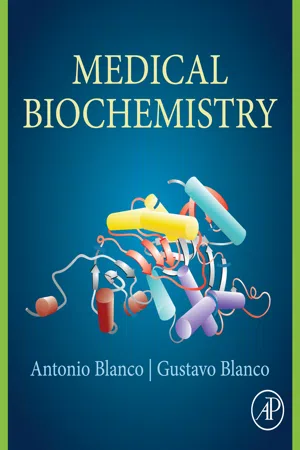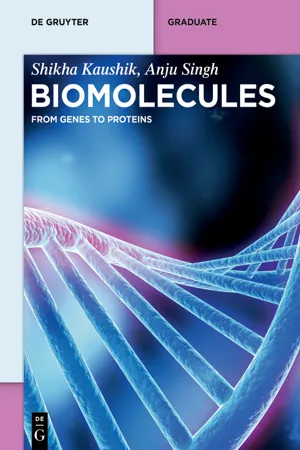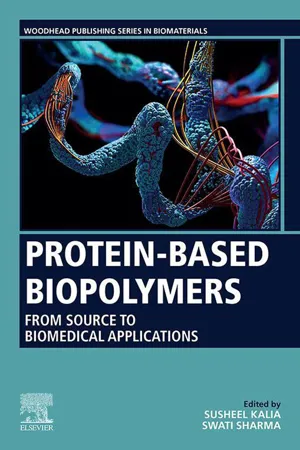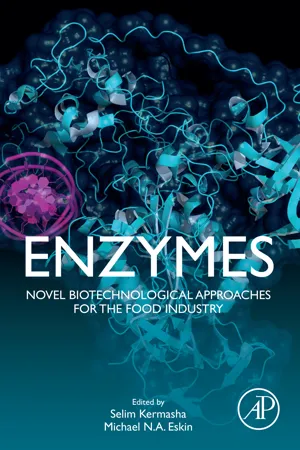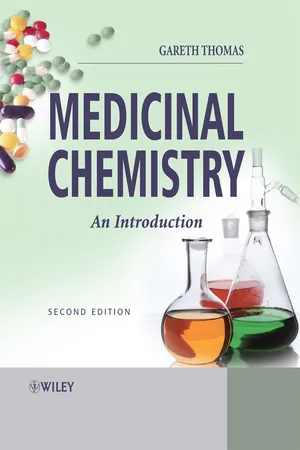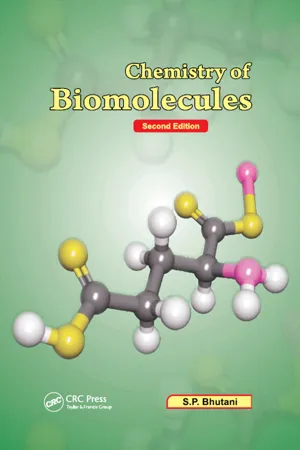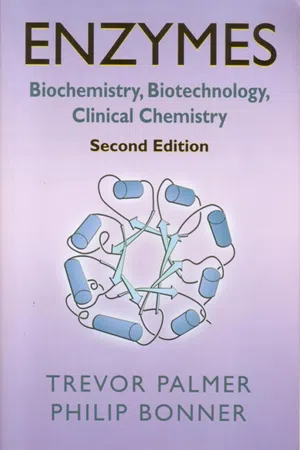Chemistry
Classes of Enzymes
Enzymes are classified into six main classes based on the type of reaction they catalyze: oxidoreductases, transferases, hydrolases, lyases, isomerases, and ligases. Each class of enzymes has specific functions and catalyzes different types of chemical reactions, playing crucial roles in various biological processes.
Written by Perlego with AI-assistance
Related key terms
Related key terms
1 of 4
Related key terms
1 of 3
9 Key excerpts on "Classes of Enzymes"
- eBook - ePub
- Antonio Blanco, Gustavo Blanco(Authors)
- 2017(Publication Date)
- Academic Press(Publisher)
e ) (see p. 152). Enzymes are more effective than most inorganic catalysts; moreover, enzymes show a greater specificity of effect. Usually inorganic catalysts function by accelerating a variety of chemical reactions, whereas enzymes catalyze only a specific chemical reaction. Some enzymes act on different substances, but generally, these are compounds with similar structural characteristics and the catalyzed reaction is always of the same type.The substances that are modified by enzymes are called substrates .The specificity of enzymes allows them to have high selectivity to distinguish among different substances and even between optical isomers of a compound. For example, glucokinase, an enzyme that catalyzes d -glucose phosphorylation, does not act on l -glucose.Nomenclature and classification of enzymes
Enzymes are often named by adding the suffix -ase to the name of the substrate that they modify. For example, amylase, urease, and tyrosinase are enzymes that catalyze reactions involving starch, urea, and tyrosine, respectively. Enzymes are also designated by the type of reaction catalyzed, for example, dehydrogenases and decarboxylases catalyze hydrogen and carboxyl removal from different substrates, respectively.Certain enzymes have arbitrary names; among them are saliva ptyalin, gastric pepsin, and pancreatic trypsin and chymotrypsin.The confusion created by the use of names according to different criteria, led the International Union of Biochemistry and Molecular Biology (IUBMB) to propose a classification system, to assign each enzyme a descriptive name and a number that allows its unequivocal identification. In this classification, six main Classes of Enzymes are considered according to the type of reaction catalyzed. Each class is divided into subclasses and sub-subclasses. The numeric code used to identify the enzyme consists of four components: the first number corresponds to the main enzyme class, the second refers to the subclass, the third denotes the sub-subclass (these numbers are assigned taking into account the nature of the atom groups involved in the reaction), and the fourth represents the enzyme order number in its sub-subclass. Periodically the IUBMB publishes the nomenclature of enzymes giving their systematic name, type of substrates used, and reaction catalyzed; the common or recommended trivial name and the code number is also indicated. To accurately identify an enzyme, the code number must be mentioned. In this book, the trivial name recommended by the IUBMB will be used, except for cases, in which the use has imposed another denomination. - eBook - ePub
Biomolecules
From Genes to Proteins
- Shikha Kaushik, Anju Singh(Authors)
- 2023(Publication Date)
- De Gruyter(Publisher)
2 per second. One of the most important functions of enzymes is to help in the digestion of food. Digestive enzymes break down the large complex molecules such as carbohydrates, proteins, and fats into smaller ones, and allow the nutrients obtained from food to be absorbed by the body. Without these digestive enzymes, animals would not be able to break down these complex molecules and would not get energy and nutrients which they require for their survival. In enzymatic reactions, the substrate molecules are converted into different molecules, known as products. These biocatalysts increase the rate of reaction without themselves undergoing any change. Their catalytic power is extremely high in comparison to that of inorganic catalyst. Almost all chemical reactions in a biological cell needs enzyme in order to occur at rates which are crucial for the existence of life, and they are known to catalyze more than 5,000 biochemical reactions. Nearly all enzymes are proteins, except few, which are catalytic RNA molecules (called ribozymes).3.1 Classification of Enzymes
There are different ways of naming and classifying an enzyme. Mostly, the enzymes have been named by adding suffix –ase to the name of the substrate, while some are named by a word describing their activity. The first active enzymes, zymases, were found in yeast. Zymase catalyzes the fermentation of glucose to ethyl alcohol and carbon dioxide. Urease catalyzes the hydrolysis of urea, and DNA polymerase carries out the synthesis of DNA in the cell. The names of some of the enzymes also describe their functions like oxidases catalyze oxidation reactions, while digestive enzymes such as pepsin and trypsin do not carry the substrate name or suffix –ase and help in digestion. Sometimes, two different enzymes can have the same name or one enzyme can have more than two names. To remove such ambiguity and for uniformity in naming, the International Commission on Enzymes was established by the International Union of Biochemistry (now known as the International Union of Biochemistry and Molecular Biology, IUBMB), which devised a common system and nomenclature for classification of enzymes in 1961. According to IUBMB, enzymes have been classified into six classes on the basis of the reaction they catalyze, and each class is identified by an EC (Enzyme Commission) number. EC numbers are represented by four components (say 1.2.3.4) separated by periods, where first number (1) shows the main class to which the enzyme belongs, the second figure (2) is the subclass, the third figure (3) gives the sub-subclass, and the fourth figure (4) is the sub-sub-subclass. The subclass and sub-subclass describe the reaction, while the sub-sub-subclass is a serial number used to identify a particular enzyme within a sub-subclass (based on the actual substrate in the reaction). This classification does not consider the homology of amino acid sequences, structure of protein, or chemical mechanism involved. For example, alcohol dehydrogenase (EC number is 1.1.1.1), belonging to the oxidoreductase family, catalyzes the oxidation of ethanol to acetaldehyde using NAD+ (nicotinamide adenine dinucleotide) and NADP+ (nicotinamide adenine dinucleotide phosphate). The systematic name of this enzyme is alcohol:NAD+ oxidoreductase. However, it was noticed that none of these classes define the enzymes that carry out the movement of ions across the cell membranes, and hence, a new class of enzyme, translocases (EC7), was added in 2018. The classification of enzymes and their examples are given in Table 3.1 - eBook - ePub
Protein-Based Biopolymers
From Source to Biomedical Applications
- Susheel Kalia, Swati Sharma(Authors)
- 2022(Publication Date)
- Woodhead Publishing(Publisher)
Layer et al., 2001 ). All these therapeutic applications require enhanced production of enzymes, including their isolation and purification, which present tremendous economic challenge to the pharmaceutical sector. Another factor entails the storage and preservation of the enzymes under ambient conditions for a prolonged time period. Hence, researchers are looking for viable options by carrying out a detailed investigation of the structure-function relationships in vivo.The aim of this chapter is to illustrate, using specific enzymes from each class of enzymes, the importance of those enzymes, especially in the biomedical sector. In order to utilize the enzymes, diverse methodologies have been explored to immobilize them onto the surfaces of specific materials or to incorporate or entrap the enzymes in various biocompatible materials. Both simple chemical methods as well as complex biochemical reactions have been employed by different research groups to immobilize or entrap the enzymes, which have been reviewed in this chapter. At times, genetic modification of the enzymes is exploited, so as to bind the enzymes in a more efficient manner. In addition, different innovative and biocompatible materials were also designed and utilized in order to obtain various efficacious bioconjugates with the enzymes. Such aspects have been perused in this chapter, while exploring the current research related to enzyme-based biosensors as well as enzyme-based drug delivery systems. The challenging processes of different bioconjugate designs have taken into consideration the effectiveness in the specific applications of the enzymes, in terms of both sensitivity as well as selectivity, which are expected from every enzymatic protein.12.2 Classification of enzymes
Classification of enzymes can be carried out on the basis of different criteria, such as the different substrates with which the enzymes interact, the location of the enzyme as well as the type of reaction the enzyme catalyzes. The currently used nomenclature of the enzymes, according to the International Union of Biochemistry, is based on reaction type as well as the substrate of the enzymatic reaction (Table 12.1 ). Thus, six major categories of enzymes have been adopted, namely the oxidoreductases, transferases, hydrolases, lyases, isomerases, and ligases (Komoda & Matsunaga, 2015 - eBook - ePub
Biomass, Biofuels, Biochemicals
Advances in Enzyme Catalysis and Technologies
- Sudhir P. Singh, Ashok Pandey, Reeta Rani Singhania, Christian Larroche, Zhi Li(Authors)
- 2020(Publication Date)
- Elsevier(Publisher)
For this reason, some of these enzymes were previously classified as ATPases in the class of hydrolases (EC 3.6.3), although hydrolysis was not their primary function. According to the type of ion or molecule translocated, they are divided into six subclasses: enzymes that catalyze the translocation of hydrons, hydron being the general name for H + in its natural abundance (EC 7.1); enzymes that catalyze the translocation of inorganic cations and their chelates (EC 7.2); enzymes that catalyze the translocation of inorganic anions (EC 7.3); enzymes that catalyze the translocation of amino acids and peptides (EC 7.4); enzymes catalyzing the translocation of carbohydrates and their derivatives (EC 7.5); and finally, the enzymes catalyzing the translocation of other compounds (EC 7.6) [110]. 2.3 Conclusions and perspectives Enzymes are powerful biocatalyzers that are intensively and continuously studied due to their high and diversified applications in the biotechnology industry and human and animal health. The seven Classes of Enzymes were presented. They are mainly classified according to the catalyzed reactions: oxireductases, transferases, hydrolases, lyases, isomerases, ligases, and the new recently defined class, the translocases. They are all extensively studied and the information about their classification, identification, and sequence is available in different databases developed in universities and research institutes (BRENDA, PDB, CAZy, EXPLORE-ENZ, and others), which are highly specialized in the subject. With this organized and significant information about the classification and catalytic properties of enzymes, numerous advances and the search for new enzymes will certainly be easily handled by researchers from all over the world. References 1. Almonacid DE, Babbit PC. Toward mechanistic classification of enzyme functions. Curr Opin Chem Biol. 2011;15:435–442. 2 - eBook - ePub
Enzymes
Novel Biotechnological Approaches for the Food Industry
- Selim Kermasha, Michael N.A. Eskin(Authors)
- 2020(Publication Date)
- Academic Press(Publisher)
Chapter Two: Enzymes
Selim KermashaaMichael N.A. Eskinba McGill University, Montreal, Quebec, Canadab University of Manitoba, Winnipeg, Manitoba, CanadaAbstract
Enzymes are biological catalysts responsible for the multitude of biochemical reactions taking place in the cells of every living species whether human, animal, insect, plant, or microbe. They are indispensable for our survival and over the years have found a broad application in the production of foods and medicines. The development of more sophisticated techniques over the past half century has completely opened-up new areas of understanding about enzymes. enzyme kinetics, and their classification in terms of reaction mechanism, cofactors and the type of reaction catalyzed. Compared to the initial enzyme classification, the latest one is far more comprehensive with detailed information available on the specific website, ExplorEnz site. It is just over 100 years since the Michael-Menten enzyme kinetics was first introduced and it remains one of the important basic kinetic parameters for enzymes. Nevertheless, enzyme kinetics has greatly expanded our understanding of the mechanisms and functions of enzymes. This has been achieved using a range of sophisticated techniques including NMR. Computational enzymology is another technique that is advancing our understanding of enzyme catalysis. In addition to enhancing the heat stability of selected enzymes, the development of artificial enzymes has radically changed our understanding of catalysis.Keywords
enzymes nature of enzymes enzyme structure and mechanism mechanism of action enzyme kinetics latest developments in enzymology2.1. Introduction
The majority of enzymes are proteins, which determine their catalytic capacity. This capacity is due to the sequence of amino acid residues of a given protein molecule and its three-dimensional conformation. With exceptional cases, amino acid residues of a given enzyme molecule are l - isomers rather than the d - eBook - ePub
Medicinal Chemistry
An Introduction
- Gareth Thomas(Author)
- 2011(Publication Date)
- Wiley(Publisher)
9 Enzymes 9.1 Introduction Enzymes act as catalysts for almost all of the chemical reactions that occur in all living organisms. Their important general characteristics are:- mild conditions are required for the enzyme action;
- they have a big capacity, a minute amount of enzyme rapidly producing a large amount of a product;
- they usually exhibit a high degree of specificity;
- their activities can be controlled by substances other than their substrates.
Enzymes are usually large protein molecules that are sometimes referred to as apoenzymes . However, some RNA molecules, known as ribozymes (see section 9.14), can also act as enzymes. The structures of a number of enzymes contain groups of metal ions, known as clusters (see section 13.2.4), coordinated to the peptide chain. These enzymes are often referred to as metalloenzymes .Some enzymes require the presence of organic compounds known as coenzymes (Fig. 9.1 ) and/or metal ions and inorganic compounds referred to as cofactors before the enzyme will function. Coenzymes and cofactors are separate chemical species that are bound to the apoenzyme by electrostatic bonds, hydrogen bonds and van der Waals' forces. These composite active enzyme systems are known as holoenzymes :However, the term enzyme is commonly used to refer to both holoenzyme systems and those enzymes that do not require a coenzyme and/or cofactor.Figure 9.1Examples of the varied nature of coenzymesEnzymes are widely distributed in the human body. It has been reported that there are over 3000 in a single cell. They are found embedded in cell walls and membranes as well as in the various biological fluids in living organisms. All enzymes are produced by cells and mainly function within that cell. It is often difficult to isolate and purify enzymes, however several thousand enzymes have been purified and characterised to some extent.A number of enzymes are produced by the body from inactive protein precursors. These precursors are known as proenzymes or zymogens - eBook - ePub
- S. P. Bhutani(Author)
- 2019(Publication Date)
- CRC Press(Publisher)
3Enzymes
Learning Objectives In this chapter we will study • Enzymes – Nomenclature and Classification • Characteristics of Enzymes – Catalytic Power, Enzyme Specificity and Stereo-specificity • Factors Influencing Enzyme Activity – Effect of Temperature and pH on Enzyme Activity; Effect of Substrate and Enzyme Concentration • Cofactors and Coenzymes• Some Important Coenzymes – NAD+ , NADP+ , Coenzyme A, Pyridoxal-5-phosphate, FMN, FAD, TPP• Enzyme Inhibitors • Mechanism to Enzyme Catalysis – Lock and Key Model • Alcoholic Fermentation • Glycolysis • Citric Acid Cycle • Introduction to Green Chemistry • Biocatalysis–Importance in Green Chemistry and Chemical Industry3.1 INTRODUCTION
We consume various food ingredients - carbohydrates, proteins and fats - any time we take our meals. These are digested and give us energy for performing the various metabolic functions in our body. The secret ingredient in living organisms is catalysis. The catalysts in living cells which facilitate the metabolic reactions are called enzymes. The miracle of life is that chemical reactions in the cell occur with great accuracy and at astonishing speed. Without the proper enzymes to process the food we eat, it might take us years to digest our breakfast or lunch.With the exceptions of some RNAs that have catalytic activity, all enzymes are proteins or their derivatives and vary in molecular weight from 10,000 up to 5,00,000. Of all the functions of proteins, catalysis is probably the most important. In the absence of catalysis, most reactions in biological systems would take place too slowly to provide products at an adequate speed for a metabolising organism. A number of enzymes have been isolated and obtained in a crystalline form. Other enzymes are derivatives of proteins formed by combination with some other group such as a metal. Enzymes containing a wide range of metals including iron, copper, zinc, manganese and magnesium are known. In other cases, the protein is combined with a non-proteinous organic molecule. We shall study these under cofactors. - eBook - ePub
- Azhar ul Haque Sario(Author)
- 2023(Publication Date)
- tredition(Publisher)
In conclusion, the world of catalysts is a domain of endless possibilities and profound implications. From industrial processes to biological systems, catalysts are integral in accelerating reactions while remaining unchanged, embodying the concept of efficiency and sustainability in the chemical world. Their study not only opens doors to technological advancements but also provides a deeper understanding of the natural processes that govern our world. The ongoing research and development in this field are sure to yield groundbreaking discoveries and innovations, further cementing the importance of catalysts in both scientific and everyday contexts.Enzymes, vital biological molecules, predominantly proteins, serve as catalysts in nearly all cellular processes. Their significance cannot be overstated; they are the linchpins in the intricate machinery of life, driving and regulating the multitude of biochemical reactions that occur within living organisms.Understanding enzymes is a fascinating journey into the world of biology, revealing how these proteins orchestrate the symphony of life's processes. Fundamental Nature of Enzymes:Enzymes are essentially proteins, composed of long chains of amino acids. These chains fold into unique three-dimensional structures, critical for their function. The sequence and nature of the amino acids in these chains determine the specific shape and function of each enzyme. This specificity is akin to a lock and key mechanism, where the enzyme (the lock) precisely fits with its substrate (the key).Role as Biological Catalysts:Enzymes, as biological catalysts, perform this role within living organisms. They speed up metabolic reactions to a remarkable extent, often making reactions millions of times faster than they would occur without the enzyme. This acceleration is crucial for sustaining life, as many biochemical reactions would be too slow to support life processes without the presence of enzymes.Diversity and Specificity:There is a vast diversity of enzymes, each tailored to catalyze a specific reaction. This specificity ensures that enzymes act only on particular molecules, known as substrates, and catalyze only certain reactions. This selectivity is fundamental to maintaining order within the biological systems, preventing chaos that would ensue if reactions occurred indiscriminately. - eBook - ePub
Enzymes
Biochemistry, Biotechnology, Clinical Chemistry
- T Palmer, P L Bonner(Authors)
- 2007(Publication Date)
- Woodhead Publishing(Publisher)
malate dehydrogenase . This enzyme mediates the removal of hydrogen from malate to produce oxaloacetate:(1.3)However, malate dehydrogenase, like many other enzymes, has been known by more than one name.So, because of the lack of consistency in the nomenclature, it became apparent as the list of known enzymes rapidly grew that there was a need for a systematic way of naming and classifying enzymes. A commission was appointed by the International Union of Biochemistry (later re-named the International Union of Biochemistry and Molecular Biology, IUBMB), and its report, published in 1964, forms the basis of the currently accepted system. Revised editions of the report were published in 1972, 1978, 1984 and 1992. An electronic version is now maintained by the IUBMB on an accessible web-site, and this is updated on a regular basis.1.3.2 The Enzyme Commission’s system of classification
The Enzyme Commission divided enzymes into six main classes, on the basis of the total reaction catalysed. Each enzyme was assigned a code number, consisting of four elements, separated by dots. The first digit shows to which of the main classes the enzyme belongs, as follows:First digit Enzyme class Type of reaction catalysed 1 Oxidoreductases Oxidation/Reduction reactions 2 Transferases Transfer of an atom or group between two molecules (excluding reactions in other classes) 3 Hydrolases Hydrolysis reactions 4 Lyases Removal of a group from substrate (not by hydrolysis) 5 Isomerases Isomerization reactions 6 Ligases The synthetic joining of two molecules, coupled with the breakdown of the pyrophosphate bond in a nucleoside triphosphate The second and third digits in the code further describe the kind of reaction being catalysed. There is no general rule, because the meanings of these digits are defined separately for each of the main classes. Some examples are given later in this chapter. Note that, for convenience, and in line with normal practice, some structures are written in a slightly simplified form in the lists provided. So, for example, in the case of the acyl group, which is transferred in reactions catalysed by E.C. 2.3 enzymes, it should be understood that the structure written -COR represents:
Index pages curate the most relevant extracts from our library of academic textbooks. They’ve been created using an in-house natural language model (NLM), each adding context and meaning to key research topics.
Explore more topic indexes
Explore more topic indexes
1 of 6
Explore more topic indexes
1 of 4
